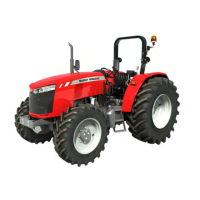Safety Notes
16
410/420/430 - 001 8903 U1
UZEL
Fig. 16
To avoid rear overturns
WARNING: Hitching to the rear axle, or
any other point above the swinging
drawbar, can cause a rear overturn.
*DO NOT pull anything using the top link
connection, or from any point above the centre line
of the rear axle. Always use an approved Massey
Ferguson drawbar, and only use a drawbar pin
that locks in place.
*High hitching can cause rear overturn, which may
cause serious injury or death. Hitch loads to the
drawbar only.
*Only use a three-point linkage drawbar when stays
are fitted to keep it in the down position.
*Use front counterweights to increase tractor
stability when towing a heavy load or to counter
balance a heavy rear mounted implement (Fig.17).
*Start forward slowly and gradually increase your
speed. DO NOT rev the engine or drop the clutch.
If the tractor is attached to a heavy load, or
immovable object, improper clutching may cause
overturn.
*If the front end of the tractor starts to lift, reduce
your speed and, if necessary, disengage the clutch.
*If your tractor is bogged down in mud or frozen
to the ground, DO NOT attempt to drive forwards.
The tractor can rotate around its rear wheels and
overturn. Lift any attached implement and attempt
to BACK OUT. If this is not possible, tow it out with
another vehicle.
*If you get stuck in a ditch, BACK OUT, if possible.
If you must go forward, do it slowly and carefully.
*A bare tractor or tractor with rear mounted
attachments should be backed up the slope in
reverse and travel forward downhill.
*A tractor with a loaded front-end bucket should
be backed down the slope and travel forward uphill.
Keep the loader bucket as low as possible.
*Always keep the tractor in gear when going
downhill. DO NOT permit the tractor to coast with
clutch disengaged or transmission in neutral.
Fig. 17

